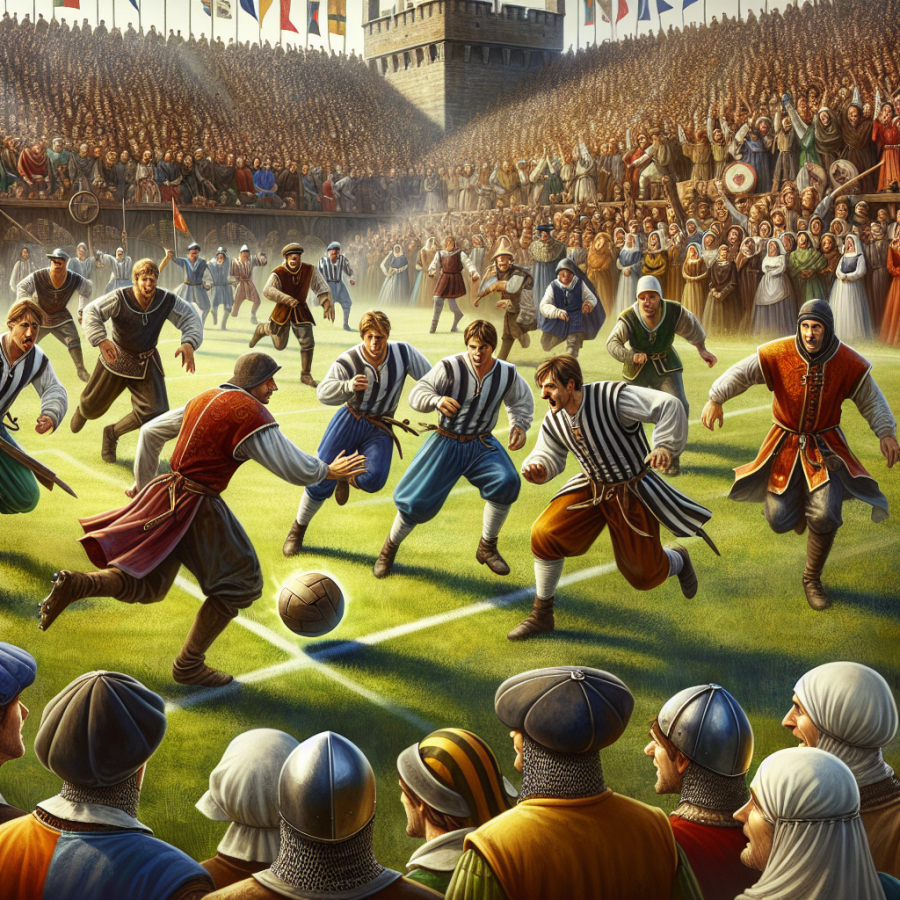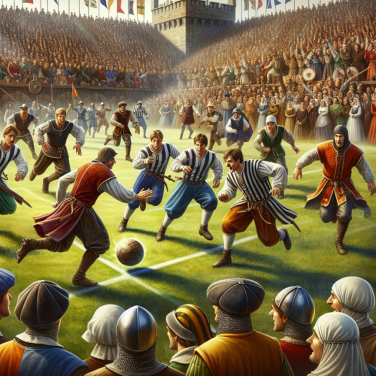Medieval Football: A Test of Strength, Endurance, and Grit
Medieval football, often referred to as mob football, was a world apart from the sophisticated, rule-bound sport we recognize today. This early form of the game was a test of strength, endurance, and grit, where entire towns would clash in a chaotic melee that bore more resemblance to a pitched battle than athletic contest.
The origins of medieval football can be traced back to various ball games played across Europe during the Middle Ages. The specific rules—if they could be referred to as such—varied widely from one place to another, but what most of these games had in common was a lack of regulation. The object of the game was to move a ball from one designated spot to another, which could be a distance of a few hundred yards, or in some cases, several miles. This often meant through streets, across fields, forests, and rivers, with the two opposing teams comprising anyone and everyone from the community willing to join in the fray.
The ball itself was no modern soccer or rugby ball; it was typically made out of an inflated pig's bladder, encased in leather. The players had to kick, throw or carry the ball, and there were very few rules regarding how this could be achieved. This meant that violence and rough play were accepted—often even encouraged—parts of the game. It was not uncommon to see players come out of these matches with broken bones, and there are records of medieval football resulting in serious injuries and even fatalities.
The sheer physicality required to participate in medieval football was staggering. Players would not only have to be able to run and maneuver through the urban or rural terrain but also wrestle, fight, and stand their ground against potentially scores of opponents at once. The games could last for hours until one team succeeded in getting the ball to their appointed goal, with little to no rest, and very little concern from spectators about the potentially life-threatening roughness of the play.
These football matches served as a form of mass entertainment, drawing together members of a community in an event that blurred the lines between sport, celebration, and open conflict. The contests were often held on significant holidays, particularly Shrove Tuesday, where they became part of the revelry of the community's preparations for Lent.
For those who participated, medieval football was an opportunity to display one's physical prowess and courage in the rawest form possible.
Read also:
Mastering Skat: Strategies for the Classic Card Game
Unraveling the Chaos of Medieval Football Matches
As we delve deeper into the heart of Medieval football, it becomes increasingly clear that these historical matches bore only a faint resemblance to the structured, rule-bound sport we know today. In an age where societal structures were rigidly hierarchical and daily life was often monotonous, these games provided an uncommon opportunity for the masses to let loose their pent-up energy and frustrations.
The chaos of Medieval football is not easily overstated; games were volatile events with rules that were loose at best and nonexistent at worst. The objective remained somewhat consistent – to move a ball from one point to another, often a distance of several miles. However, the means by which players achieved this goal could be shockingly unruly. The ball, which could be made of anything from an inflated pig’s bladder to a leather-stuffed sphere, became the center of a mass brawl that sprawled across towns and countryside.
Teams were typically formed from the young men of opposing villages or parishes, and a sense of local pride turned the matches into fierce competitions. It wasn’t merely a game; it was a battle for communal honor waged through a spherical proxy.
The rules – to the extent that any existed – varied from one locale to another. Some games allowed the use of hands, while others were strictly kicked. Yet, regardless of the local customs, Medieval football had a consistent thread of violence and disorder. Tackles could include wrestling moves, punches, or any other physical means to wrest the ball away or take out a rival.
The size of the pitch was another variable factor, often simply being the space between two predetermined landmarks, which could be anything from adjacent villages to a couple of trees within a single settlement. This meant that the game field could span fields, streams, and everything in between, turning each match into a marathon of strategic physical confrontation.
Village fixtures, bridges, and even local marketplaces could be caught up in the pandemonium, as players chased, kicked, and fought over the ball with scant regard for property or personal safety. Stories abound of windows shattered, stalls upturned, and citizens accidentally caught up in the mayhem. This disregard for the bystander and environment underscores the anarchic spirit that suffused the game.
Injuries were commonplace and often severe, with broken limbs and even fatalities reported, reflecting the full-contact nature of the sport. The danger inherent in these football matches meant they were not a pastime for the faint of heart.




